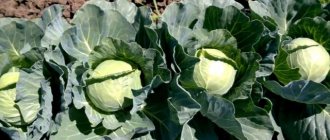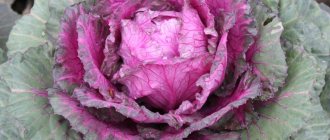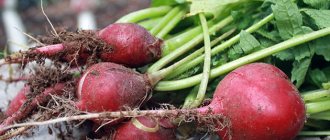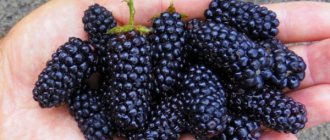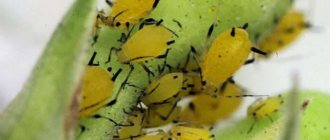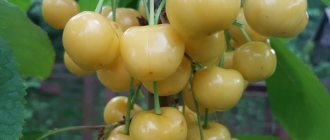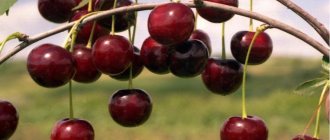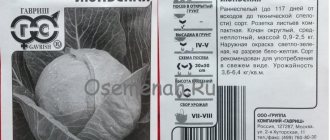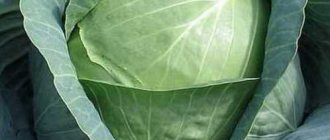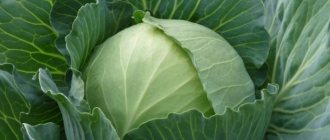Vegetable growing » Cabbage
0
1206
Article rating
Kira Stoletova
Cyclops cabbage category f1 is valued by gardeners for its excellent taste when pickled. Its high yield rates and ease of care are noted.
Description of cabbage Cyclops
Description and characteristics of the variety
Cabbage Cyclop F1 belongs to the line of mid-late hybrids. The growing season lasts
- 85-90 days from the date of planting seedlings in the ground
- and 120-140 days from the moment of germination.
White cabbage has the following characteristics:
| Signs | Peculiarities |
| Socket | Strong, powerful, raised, 60 cm in diameter |
| Kocheryga (internal and external) | Length average |
| Coloring | Green outside, yellowish inside |
| Leaves | Small in size, wide-oval shape |
The forks are compact and have good density. Can be used for salads, fermentation, making borscht, cabbage rolls, and pies.
What are the properties of heads of cabbage:
| Options | Description |
| Average weight | 2.3-4.4 kg |
| Form | rounded |
| Taste rating | By 4.5 points |
| Juiciness | good |
The hybrid has powerful immunity, does not suffer from fusarium and is practically not affected by thrips.
Description of the hybrid
The originator of Cyclops cabbage is the Japanese company Sakata. On the package with seeds you can see the F1 marking, which indicates that this cabbage variety is a hybrid. Refers to mid-season varieties. It has been grown in our country since 2011. Can be cultivated in different climatic zones.
Brief description of the plant:
- The cabbage bush is quite powerful, the leaf rosette is raised.
- The leaves are medium in size, greenish-gray in color.
- The fruit is round in shape, slightly flattened, partially covered with leaves (see photo). The head of cabbage is compact, dense in structure, without voids.
| View | White cabbage |
| Head of cabbage, stalk | Round, dense. Inner and outer stumps short or medium |
| Fetal weight | 2.5-5 kg |
| Planting scheme | 50x50-60 cm |
| Ripening period | Mid-season (120-140 days from germination) |
| Drop off point | exhaust gas/greenhouse/greenhouse |
| By type of use | Universal |
| Diseases | Resistant to Fusarium wilt, bacteriosis, can be susceptible to black rot and clubroot |
Advantages and disadvantages
Pros:
- versatility of use;
- possibility of cultivation in open and protected beds;
- excellent taste;
- presentable presentation;
- protection from cabbage infections;
- stress resistance;
- cold resistance;
- good heat tolerance;
- high germination rate.
Minuses:
- the need for planting in sunny areas;
- the need for systematic watering.
Reviews
The cabbage variety Cyclops is quite popular among gardeners, who give it positive reviews:
- Tatyana Fedorovna from Chelyabinsk liked the Cyclops hybrid. Her cabbage grew tasty, stored well and was perfect for pickling.
- Tatyana Kazantseva from the Irkutsk region also positively assessed this cabbage and will continue to plant it.
- And Vladislav Igorevich from Voronezh is just going to try this variety on the recommendation of a farmer he knows, who considers this Japanese cabbage very good.
Cabbage Cyclop F1 is perfect for beginners and experienced gardeners. It is often used for industrial plantings, because this hybrid is tasty and productive, resistant to diseases and pest attacks.
Growing and care
Traditional cultivation algorithm:
| Procedures | Nuances |
| Watering | Use warm water (20-24 degrees) Frequency 1 time every 7-8 days in humid conditions, 2-3 times in hot weather per week Norm per 1 m2 7-10 l |
| Feeding | Carry out 3 times (14 days after transplantation and during formation) Use nitrogen and phosphorus-potassium complexes Recommended fertilizers - nitroammophoska, saltpeter, solutions of mullein and humus, bioinfusions, Sudarushka, Effecton, Agricola |
| Loosening | Loosen after showers and moisture Depth 4 cm Use hoes, flat cutters |
| Hilling | Multiplicity 1 time 15-20 days Height 18-20 cm Embankment diameter 20 cm |
| Preventive actions | Use biological products and folk remedies |
3 weeks before harvesting, stop moistening the beds. This way you can prevent rotting during storage.
Rules of care
Caring for plants is easy
The variety requires standard care, which consists of weeding, watering and fertilizing.
Watering is carried out once every 5-7 days using warm water. It is recommended to pour at least 3 liters of water under each bush. It is recommended to install a drip irrigation system so that the moisture is distributed evenly. After each watering, you need to loosen the soil and weed the area to remove ingrown weeds. The weeding depth should be 6 cm so as not to disturb the roots of the plant.
Feeding is carried out in several stages.
- The first is carried out during planting in open ground. At this point, organic fertilizers are used (3 kg of humus or 2 kg of bird droppings per square meter).
- The second is carried out during the cabbage flowering period. At this point, it is preferable to use phosphorus components. 20 mg of superphosphate is diluted in 10 liters of water.
- The third - with the beginning of fruiting. It is necessary to dilute 40 mg of potassium nitrate, dilute it in 10 liters of water and pour about 2 liters of the substance under each bush.
Agricultural technology
Our hero is suitable for growing in seedlings and without seedlings. To obtain maximum performance, planting density should not exceed 35 thousand plants per hectare. Our hero requires increased agricultural technology. Watering should be stopped 2 weeks before harvesting.
The Cyclops hybrid is of interest not only for growing on private farms, but also on an industrial scale. The plant is unpretentious, flexible, with good immunity. For farmers, excellent marketability and taste, as well as suitability for processing, are of particular interest. In general, a good culture is still not without its shortcomings. Despite decent stability, the yield of the variety is not very high. In addition, cabbage is demanding on a high agricultural background.
Fighting parasites and diseases
The Cyclops variety of category f1 is resistant to bacteriosis, but it can be susceptible to black rot and clubroot.
It is impossible to cure black rot, so you will have to remove the entire bush at once. In the fight against clubroot, a solution of Bordeaux mixture is used, which is sprayed (2 mg per 10 liters of water).
The main pests include beetles and flea beetles. You can fight them with a spray solution of colloidal salt or manganese (2 mg of the drug per 10 liters of water). Spraying is carried out every 10 days until the parasites are completely destroyed.
Cyclops F1 is a unique Japanese hybrid of white cabbage. Cyclops is included in the State Register of the Russian Federation and is recommended for cultivation in two regions, the Central and North Caucasus.
The hybrid is recommended to be grown for fresh consumption or for processing, in particular for pickling. And in today’s publication you will get acquainted with this Japanese cabbage, study the description of the variety, see photos and read reviews of summer residents who have encountered the Japanese vegetable personally.
Advantages and disadvantages of Japanese cabbage
Residents of the Land of the Rising Sun have been using cabbage salad for a very long time. The only disadvantages include individual taste intolerance or allergic tendencies.
Another disadvantage is the short fresh storage time: prepared salads with the addition of Japanese cabbage must be eaten immediately after preparation, otherwise the leaves quickly wither and lose their taste. This quality is compensated by the ability to retain beneficial properties during pickling, freezing, and drying.
The description of its advantages takes up more than one line; in Japan, the vegetable is considered a medicinal plant.
- Japanese cabbage contains: vitamins C, B1, B2, PP, carotene, potassium, calcium, phosphorus, iron, fiber.
- Strengthens the immune system.
- Contains anti-cancer substances.
- Due to its low calorie content, it is included in weight loss diets.
- It has the ability to remove toxins and salt deposits from the body.
- Cleanses the intestines and organs and helps improve the functioning of the digestive system.
The dishes are recommended for everyone to strengthen their protective functions during the off-season when there is a lack of vitamins. It is especially recommended for those who suffer from cancer, heart disease, digestive system disorders, anemia and weight loss.
Characteristics of the variety
The cabbage variety Cyclops is a product of Japanese selection. It is suitable for cultivation in all regions of the country. The variety is mid-season, its growing season is 3 months from the moment of planting in a permanent place.
According to the description, the leaves are light green in color and round in shape. There is no waxy coating on their surface. The leaf rosette is medium in size, diameter is about 60 cm. The head of cabbage is medium in size, its weight is 3-5 kg. High yields are noted. About 600 kg of selected products are collected from 1 hectare.
Cyclops f1 is a variety of white cabbage characterized by excellent taste. Predominantly sweet taste with a slight note of spiciness. Cabbage contains a large amount of sugar (8% per 100 g), vitamin C (12 mg) and carotene (7%).
The variety is suitable for fresh consumption; it is often used for preparing salads or main dishes (borscht, cabbage soup, stew, etc.). Due to the density of the head of cabbage, large and long fibers are obtained during shredding.
Reviews from gardeners
Tatyana Fedorovna, Chelyabinsk, 39 years old.
In 2021, we bought Cyclops f1 seeds on the market. The cabbage grew good and tasty. Stores well too. You can also ferment it.
Vladislav Igorevich, Voronezh, 54 years old.
We grow cabbage mainly for pickling. We really love her this way. We have always grown Moscow late. Very tasty, crispy, juicy. But all the time we were growing them, we were faced with parasites. Any insect that is not too lazy will gnaw this variety. We planted marigolds and calendula, to no avail. We do not treat them with insecticides on principle, so that there are no chemicals in the vegetables. Traditional methods help, but only for a short time, and there is a lot of hassle. I asked a farmer I knew about good cabbage for pickling so that insects wouldn’t bite it. Cyclops advised. This year we will try what kind of variety it is. Speaks Japanese, very good.
Despite the fact that gardeners prefer Dutch varieties of white cabbage, Japanese selection is also worthy of attention. Therefore, if you love this vegetable in natural or pickled form, then be sure to find a place in the garden bed for the Cyclops hybrid. The applicant and originator of this unique variety with unsurpassed qualities is Sakata Vegetables Europe SAS. In 2011, the variety was included in the State Register of Breeding Achievements of Russia with admission to the Central and North Caucasus regions.
Characteristics
- Cyclops belongs to the mid-season varieties, even more likely to the mid-late ones. The harvest is harvested 85 - 90 days after transplanting the seedlings. The entire growing season takes 120 - 140 days;
- The yield is average but stable. According to the State Register, the marketable yield was 186 - 339 c/ha, which is at the level of Slava 1305 cabbage taken as the standard. In the Ivanovo region, the described crop showed the maximum result - 749 c/ha;
- The variety has strong immunity and is highly resistant to Fusarium wilt, which is confirmed by the State Register;
- there is excellent plasticity of the variety, allowing it to adapt to various conditions during the growing period;
- in the field the crop is able to maintain high commercial qualities and does not crack;
- The crop tolerates transportation well. Keeping quality is insufficient;
- method of use is universal. The vegetable is intended for consumption in its natural form, for preparing various dishes. Our hero is also recognized as one of the best hybrids for pickling. The high content of vitamin C contributes to the production of a pickled product of the highest quality, while it is noted that the cabbage does not change color. Thanks to the thin leaves, compactness of the head and small stump, there is practically no waste during processing.
Watering and fertilizing
Timely and correct watering is the key to a good harvest. Watering affects not only the development of the vegetable, but also its taste and further storage.
Water cabbage only with warm, settled water, the temperature of which reaches 20-25 C. If you water the vegetable with cold water from a well, then there is a high risk of fungal and bacterial diseases.
Water the cabbage regularly, but without fanaticism. If you water a vegetable every day, it will get used to the surface presence of water, which is why the root system will stop growing deeper.
Watering is stopped 2 weeks before harvest. This will protect the heads of cabbage from early rotting during harvest storage.
As for fertilizing, it is recommended to use nitrogen-containing fertilizers at the initial stage of cabbage development. During head formation, the crop needs potassium fertilizers.
